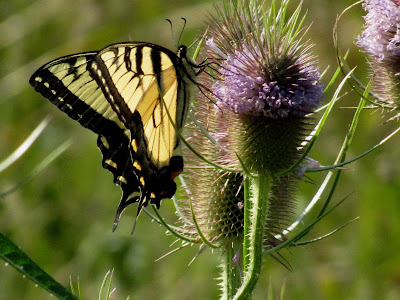Several years ago
during the late summer, my morning walk took me along the old Lehigh Railroad
bed just South of the Batavia city limits. That particular section is elevated about 15’ above the land on
either side. On the North side of the tracks is a small wetland known locally
as the “beaver swamp.” To the South, and directly below me was a fairly dense
thicket consisting mostly of osier, wild grape vine and various small trees.
Despite my vantage point from above, I wasn’t afforded much of a view other
than the top of the thicket. As it turns out, I had all the view I would
need.
Moments later there was a flash of movement below me and to my left. A Cedar Wax wing was
making haste through the tops of the scrub growth with a Cooper’s Hawk in hot
pursuit. They passed by practically within spitting distance traveling in the
opposite direction. I don’t know what the outcome was but the hawk matched its
intended quarry move for move until they disappeared from sight.
 |
| I photographed this Cooper's Hawk at the Iroquois National Wildlife Refuge. |
If ever there was a
raptor built for maneuvering through the woods at high speed, it’s the Cooper’s
Hawk and his look-alike cousin, the slightly smaller Sharp-shinned Hawk. Some
birds of prey, like the Northern Harrier, glide low over the terrain in search
of a meal, while some, like the Red-tailed Hawk hunt by circling high overhead or
from a lofty perch. Once having spotted their quarry, they will make a rapid
nose dive before pouncing on their unsuspecting victims. Not so with the
Cooper’s hawk. Their diet consists of
mainly smaller birds which they chase down with relentless pursuit, zipping
through the woodlands, performing sleek aerial maneuvers as they evade tree
limbs, tangles and brush all while staying solely focused on their prey.
 |
Despite my attempt at concealment, he’s been aware of my
presence, eyeing me warily the entire time. |
 |
Deciding whatever it is that’s watching him is not something to eat,
and in the blink of an eye, he'll be gone. |
Cooper’s hawks don’t
confine their hunting to the wild. Smaller hawks have been known to hunt in
residential areas, particularly when bird feeders offer up an easy meal. We enjoy the many colorful songbirds that are
drawn to our yard, yet we’re aware they make up a large portion of the Cooper’s
hawk’s diet. On occasion we are reminded of this sober truth upon coming across
the tell-tale clusters of Blue Jay and Northern Flicker feathers lying on the
ground and it is then that I am drawn to Ecclesiastes 3; There is a time for everything, and a season for every activity
under the heavens. A time to be born and
a time to die, a time to plant and a time to uproot, a time to kill and a
time to heal, a time to tear down and a time to build, a time to weep and a
time to laugh, a time to mourn and a time to dance……….
So goes the cycle of
life, all according to His plan.
Until Next Time,
Jim & Claudia











